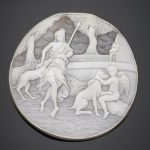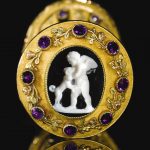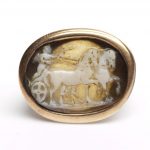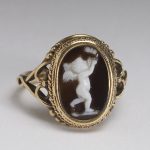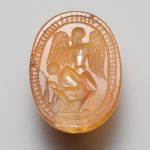Cupid Roman God of Love. Information on Cupid and his depiction in cameos throughout the ages. Cupid, ancient Roman god of love in all its varieties, the counterpart of the Greek god Eros and the equivalent of Amor in Latin poetry. According to myth, Cupid was the son of Mercury, the winged messenger of the gods, and Venus, the goddess of love. He often appeared as a winged infant carrying a bow and a quiver of arrows whose wounds inspired love or passion in his every victim. He was sometimes portrayed wearing armour like that of Mars, the god of war, perhaps to suggest ironic parallels between warfare and romance or to symbolize the invincibility of love. Reference: Encyclopaedia Britannica
In art, Cupid often appears in multiples as the Amores, or amorini in the later terminology of art history, the equivalent of the Greek erotes. Cupids are a frequent motif of both Roman art and later Western art of the classical tradition. In the 15th century, the iconography of Cupid starts to become indistinguishable from the putto.
Cupid continued to be a popular figure in the Middle Ages, when under Christian influence he often had a dual nature as Heavenly and Earthly love. In the Renaissance, a renewed interest in classical philosophy endowed him with complex allegorical meanings. In contemporary popular culture, Cupid is shown dra. wing his bow to inspire romantic love, often as an icon of Valentine’s Day. Reference: Wikipedia
An 18th – 19th century hardstone cameo clasp Depicting three classical figures, including Cupid grasping a shell sitting atop a ram, on a black ribbon, length 33.0cm
Sold for £4,375 inc. premium at Bonhams in 2017
17th century Cameo; sardonyx; Cupid lying asleep, approached from right by butterfly; figure of Cupid in a red stratum.
Reference: © The Trustees of the British Museum
A THOMAS WEBB & SONS CAMEO GLASS ALLEGORICAL VASE OF CUPID CIRCA 1880, ACID-ETCHED CRESCENT MARK, THOMAS WEBB & SONS, DESIGNED AND SIGNED IN INTALGIO G. WOODALL Oviform, the frosted brilliant blue glass wall overlaid in opaque white and deep-amethyst, the cylindrical rim wheel-engraved with flower-heads above Cupid seated on a rock before a tree, bending his bow in frustration across his knee, an empty quiver at his back, the socle with ovolo patterned bands 10 ¼ in. (26 cm.) high
Sold for USD 149,000 at Christies in 2014
Archaeological Revival Gold and Hardstone Cameo Bracelet Centering one cut-cornered rectangular cameo depicting a cupid approximately 25.0 x 18.0 mm., flanked by 2 octagon-shaped cameos depicting angels with lyres approximately 13.5 x 13.5 mm., all set within recessed frames applied with small polished gold balls and fine rope-twist gold, tipped by polished gold balls, joined by hinged finely ribbed cylinders tipped by detailed gold discs centering polished gold balls, completed by a tapered bracelet applied with a scrolled and floral motif of fine rope-twist gold and polished gold balls, circa 1880, approximately 40.6 dwts. Length 6 3/4 inches.
Cameos: translucent, one smaller cameo with chip above lyre, slightly visible to eye. Overall good condition, with normal wear and minor scratches, some discoloration to gold, some wire and small granulation bent or missing. Width 1 5/8 to 1/2 inches.
Sold for $7,500 (includes buyer’s premium) at Doyle New York in 2015
BALZANO Shell cameo with the goddess Diana, cupid and greyhounds, g 30.6, diam. cm 8. Signed Balzano.
Sold for €1,000 at Il Ponte casa d’aste in 2018
Venus Marina, Cupid at Her Side Artist:Benedetto Pistrucci (Italian, 1783–1855, active England) Date:ca. 1820–30
Amazingly, the relief’s surface is concave. Benedetto Pistrucci used his drill in a virtuoso excavation of the strata, employing the palest brown to outline the goddess’s shell and team of dolphins, shaping an exquisite bowknot from the foremost brown, and piercing the white layer perilously close to the black ground to define the sail-like drapery and dainty silken reins. The frame of about 1820–30 was later fleshed out with filigree.
Reference: The Metropolitan Museum of Art
An important Prussian Royal jewelled three-colour gold and hardstone desk seal, circa 1815-1820 the faceted slightly grey agate stem between gold mounts richly chased with coloured gold rose garlands on a sablé ground, further set with amethysts and surmounted by an onyx cameo of Cupid welcoming a friendly hound, the strip-pierced base similarly decorated and containing the large oval citrine matrix engraved with a coat of arms, unmarked, in a later Victorian leather case stamped ‘Watherston & Son’ Quantity: 2 10.2cm., 4 in. high
The matrix is engraved with the arms of Prussia within the chain of the order ‘Pour le mérite’, probably for Frederick William III (1770-1840), King of Prussia from 1797 until his death, encircled by the arms of the 21 Eastern and Western provinces and free towns, as assigned at the Congress of Vienna in 1815. Frederick William succeeded to his father’s throne in 1797, a difficult time in war-torn Europe. He was determined to stamp out court and government abuses and is recorded as saying: ‘Every civil servant has a dual obligation: to the sovereign and to the country. It can occur that the two are not compatible; then, the duty to the country is higher.’ He attempted to pursue a policy of neutrality during the Revolutionary and Napoleonic Wars but reluctantly joined the war against the French Emperor in 1806. A few weeks later, the Prussian army was defeated at Jena and was forced to sign a humiliating peace treaty by which Prussia lost many of its territories, had to finance a large indemnity and to pay for French troops to occupy key points within the kingdom. In 1813, following Napoleon’s defeat in Russia, Frederick William turned against France again, signing an alliance with Russia. Prussian troops played a key part in the victories of the allies in 1813 and 1814 and, of course, under Field Marshal Blücher at Waterloo. The King was thus able to negotiate important territorial increases for Prussia at the Congress of Vienna, celebrated in the arms engraved on the matrix of this important desk seal. As the seal is unmarked, it is not possible to know exactly where it was made. It is unlikely that it was ordered by the king himself in Berlin since he was notoriously frugal, having urged his compatriots to give up their gold and silver for the war effort and encouraging the manufacture of jewellery made of Prussian iron. It is most probable that it was given to Frederick William III after the Congress by one of his allies or, given its style, by a grateful French Royal Family.
Sold for 22,500 GBP at Sothebys in 2017
Cupid in a biga (two-horsed chariot) ca. 200 BC-100 CE (made)
Horizontal oval cameo. White over pale brownish grey layered agate. Depicts Cupid, naked and winged, driving a chariot drawn to right by two horses. Set in a later gold ring.
Reference: © Victoria and Albert Museum
Ring with Cupid Chasing a Butterfly
This ring uses naturally occurring color variations in a slice of agate to create a miniature relief of Cupid chasing a butterfly, which represents the human soul. Other neoclassical artists also represented this theme, perhaps most famously the marble by Antoine-Denis Chaudet, which is in the Louvre in Paris. The cameo is set in a pierced gold ring.
Reference: The Walter Art Museum




